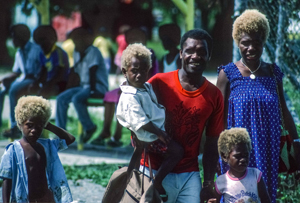May 3, 2012 - By Rosanne Spector

Researchers have identified a gene that is responsible for blond hair in 5-10 percent of the indigenous population of the Solomon Islands in the South Pacific.
The common occurrence of blond hair among the dark-skinned indigenous people of the Solomon Islands is due to a homegrown genetic variant distinct from the gene that leads to blond hair in Europeans, according to a new study from the Stanford University School of Medicine.
“This is one of the most beautiful examples to date of the mapping of a simple genetic trait in humans,” said David Reich, PhD, a professor of genetics at Harvard University, who was not involved in the study.
The study identifying the gene responsible for blond hair in the Solomon Islands, a nation in the South Pacific, represents a rare case of simple genetics determining human appearance, and shows the importance of including understudied populations in gene mapping studies, said co-senior author Carlos D. Bustamante, PhD, professor of genetics at Stanford. The findings were published May 4 in Science.
“Since most studies in human genetics only include participants of European descent, we may be getting a very biased view of which genes and mutations influence the traits we investigate. Here, we sought to test whether one of the most striking human traits, blond hair, had the same — or different — genetic underpinning in different human populations,” Bustamante said.
Globally, blond hair is rare, occurring with substantial frequency only in northern Europe and in Oceania, which includes the Solomon Islands and its neighbors. “Its frequency is between 5 and 10 percent across the Solomon Islands, which is about the same as where I’m from,” said co-first author Eimear Kenny, PhD, who was born in Ireland.
Many assumed the blond hair of Melanesia was the result of gene flow — a trait passed on by European explorers, traders and others who visited in the preceding centuries. The islanders themselves give several possible explanations for its presence, said co-senior author Sean Myles, PhD, a former Stanford postdoctoral scholar who is now an assistant professor at the Nova Scotia Agricultural College. They generally chalked it up to sun exposure, or a diet rich in fish, he said.
After researchers at UCSF generated genetic data from the samples, Kenny, a postdoctoral scholar in Bustamante’s lab, began the analysis in September 2010, the week she started at Stanford. “Within a week we had our initial result. It was such a striking signal pointing to a single gene — a result you could hang your hat on. That rarely happens in science,” she said. “It was one of the best experiences of my career.”
In terms of genetic studies, the analysis was straightforward, said Kenny. But gathering the data, accomplished in 2009 by Myles and co-first author Nicholas Timpson, PhD, was more difficult. Much of the Solomon Islands is undeveloped, without roads, electricity or telephones. It’s also one of the most linguistically diverse nations in the world, with dozens of languages spoken.
It was a return trip for Myles who had been there in 2004 as a graduate student with Max Planck Institute molecular anthropologist Mark Stoneking, PhD, (also a co-author of the study) to investigate whether the language variations correlated with genetic variations. While there, Myles was fascinated by the ubiquity of blond hair, which was especially common among children.

Stanford researchers say they were surprised that the evidence pointed so strongly to a single gene being responsible for the blond hair among Solomon Islanders. Additional photos are available here.
“They have this very dark skin and bright blond hair. It was mind-blowing,” said Myles. “As a geneticist on the beach watching the kids playing, you count up the frequency of kids with blond hair, and say, ‘Wow, it’s 5 to 10 percent.’”
A grant from the Wenner-Gren Foundation for Anthropological Research gave Myles, who at that time was doing a stint as a postdoctoral researcher at Cornell University, his chance to study the genetics of the Solomon Islanders’ hair color. Myles worked with Bustamante, who was also at Cornell, to design the study. Then back in the islands, Myles and Timpson went village to village explaining what they wanted to do and asking for permission to gather data, Myles speaking in Solomon Islands pidgin, the most widely understood language.
When the local chief gave the OK, the researchers recruited participants and assessed hair and skin color using a light reflectance meter, took blood pressure readings and measured heights and weights. They asked the villagers to spit into small tubes to provide saliva to be used for DNA extraction. In the span of a month they collected more than 1,000 samples.
While the islands fit many people’s notion of a tropical paradise, they lack amenities Westerners take for granted. For instance, simply finding a level spot for the scale to weigh study participants was a challenge.
Then in 2010 Bustamante joined Stanford’s faculty and, with funding from the Department of Genetics, the team looked for genes underlying this striking phenotype. Soon after, Kenny joined the lab and started the analysis, selecting 43 blond- and 42 dark-haired Solomon Islanders from the opposite 10 percent extremes of the hair pigmentation range. She used these in a genome-wide association study, a method to reveal differences in the frequency of genetic variants between two groups, that usually requires thousands of samples.

Carlos Bustamante
Because the vast majority of human physical characteristics analyzed to date have many genetic and environmental factors, Kenny expected an inconclusive result that would require much further study. Instead, she immediately saw a single strong signal on chromosome 9, which accounted for 50 percent of the variance in the Solomon Islanders’ hair color.
The team went on to identify the gene responsible, TYRP1, which encodes tyrosinase-related protein 1, an enzyme previously recognized as influencing pigmentation in mice and humans. Further research revealed that the particular variant responsible for blond hair in the Solomon Islands is absent in the genomes of Europeans.
“So the human characteristic of blond hair arose independently in equatorial Oceania. That’s quite unexpected and fascinating,” Kenny said.
The finding underscores the importance of genetic studies on isolated populations, said Bustamante. “If we’re going to be designing the next generation of medical treatments using genetic information and we don’t have a really broad spectrum of populations included, you could disproportionately benefit some populations and harm others.”
Bustamante is seeking funding to analyze the rest of the data gathered. “For instance, the genetics of skin pigmentation might be different there too — not the same as in Europe or Africa or India. We just don’t know.”
Additional co-authors were Stanford postdoctoral scholars Martin Sikora, PhD, and Andres Moreno Estrada, PhD; Stanford research assistant Muh-Ching Yee, PhD; and researchers from UCSF including professor of bioengineering & therapeutic sciences and medicine, Esteban González Burchard, MD. Nicholas Timpson is currently a lecturer at the University of Bristol, U.K.
In addition to the Wenner-Gren Foundation, the research was funded by the MRC Centre for Causal Analyses in Translational Epidemiology, the National Human Genome Research Institute, the National Heart, Lung, and Blood Institute and the Max Planck Society.
Information about Stanford’s Department of Genetics, which also supported the work, is available at http://genetics.stanford.edu/.
About Stanford Medicine
Stanford Medicine is an integrated academic health system comprising the Stanford School of Medicine and adult and pediatric health care delivery systems. Together, they harness the full potential of biomedicine through collaborative research, education and clinical care for patients. For more information, please visit med.stanford.edu.